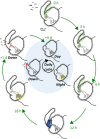Insights into flagellar function and mechanism from the squid-vibrio symbiosis
- PMID: 31666982
- PMCID: PMC6814793
- DOI: 10.1038/s41522-019-0106-5
Insights into flagellar function and mechanism from the squid-vibrio symbiosis
Abstract
Flagella are essential and multifunctional nanomachines that not only move symbionts towards their tissue colonization site, but also play multiple roles in communicating with the host. Thus, untangling the activities of flagella in reaching, interacting, and signaling the host, as well as in biofilm formation and the establishment of a persistent colonization, is a complex problem. The squid-vibrio system offers a unique model to study the many ways that bacterial flagella can influence a beneficial association and, generally, other bacteria-host interactions. Vibrio fischeri is a bioluminescent bacterium that colonizes the Hawaiian bobtail squid, Euprymna scolopes. Over the last 15 years, the structure, assembly, and functions of V. fischeri flagella, including not only motility and chemotaxis, but also biofilm formation and symbiotic signaling, have been revealed. Here we discuss these discoveries in the perspective of other host-bacteria interactions.
Keywords: Cellular microbiology; Symbiosis.
© The Author(s) 2019.
Conflict of interest statement
Competing interestsThe authors declare no competing interests.
Figures




References
-
- Jonson A-B, Normark S, Rhen M. Fimbriae, pili, flagella and bacterial virulence. Contrib. Microbiol. 2005;12:67–89. - PubMed
Publication types
MeSH terms
Grants and funding
LinkOut - more resources
Full Text Sources

